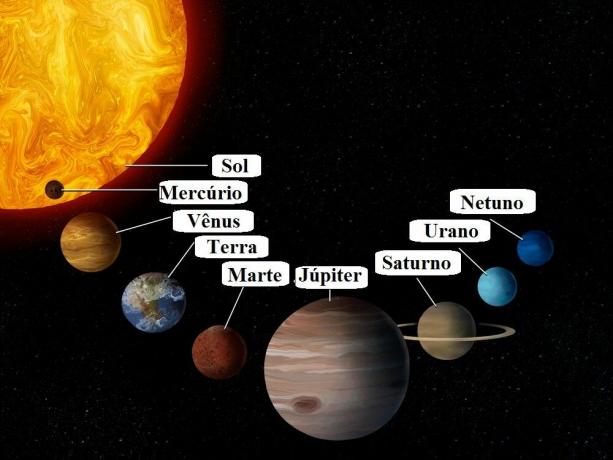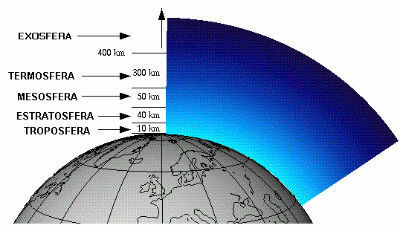You planets are heavenly bodies no light and own heat, solid, rounded and with self-gravity, which revolve around a larger star (free orbit), which in the case of planet Earth is the Sun.
Thus, in space where the cold reaches 270 °C below zero, countless spheres, illuminated by their respective suns, rotate.
Cosmology estimates that the planets in the Solar System formed approximately 4.6 billion years ago. Among other theories, scientists think it all started with an explosion of cosmic gases and dust, which would have formed a cloud and from that cloud would have appeared small solid bodies, which gave rise to the formation in galaxies, which are gigantic clusters of stars, planets, satellites, asteroids, etc.
Like all other bodies, planets and stars attract other bodies to them. The Sun, following its orbit in space, attracts planets that rotate around it, while the planets attract their respective satellites.
The speed with which the satellites revolve around your planet and the planets around the Sun gives you a
centrifugal force, which propels them out of their orbit, this force neutralizes the gravity that pulls them towards the Sun.As two opposing forces cancel each other out, planets and satellites remain in a constant orbit.
Planets of the Solar System
Our solar system it's composed by eight planets (Mercury, Venus, Earth, Mars, Jupiter, Saturn, Uranus and Neptune) and the Sun one of the countless stars of the Milky Way.
 Representation of the Solar System
Representation of the Solar System
It is the smallest planet in the Solar System, the fastest and closest to the Sun. Due to this proximity, it has temperature averages of 125°C, reaching 425°C. It completes a revolution around the Sun in 87.969 days, always keeping the same face facing it, formed by a desert of incandescent rocks. Its hidden face is dark and icy, with low temperatures. The atmosphere is quite rarefied.
It is the second closest planet to the Sun. Its size resembles the Earth, with 12,104 kilometers in diameter. Although farther away than Mercury, it has temperatures of 461°C. It is surrounded by permanent clouds of carbon dioxide, a gas that retains much of the solar heat. It takes 243 days to turn on itself and its translation movement, at a speed of 35 km per second, is approximately 225 days. The planet is known as the D’alva star and is visible from the Earth's surface.
It is a rocky sphere, 12,757 km in diameter, 149 million km away from the Sun. Rotation around its axis takes 23 hours, 56 minutes and 4,095 seconds. Rounding up we have the 24-hour day. The translation movement around the Sun is completed after 365 days and a quarter. Thus, every four years is a leap, it has 366 days. The moon is Earth's natural satellite.
It is the best visible planet on Earth, from which it is 62 million kilometers away. It takes 687 days to perform the translation movement, at a distance of 218 million kilometers from the Sun. Its day is similar to Earth's, 24 hours and 37 minutes. Its atmosphere is thin and the temperature varies around zero degrees. Mars, six times smaller than Earth, has two small moons: Phobos and Deimos.
The largest planet in the Solar System, with a diameter of 142,700 kilometers, represents 1,300 times the size of Earth. It is located 779 million kilometers from the Sun. Its year lasts for almost 12 terrestrial years. With the speed that it turns around itself, it completes a rotation in 9 hours and 55 minutes. It is formed by a rocky core, covered by a layer of thousands of kilometers of ice. The atmosphere is made up of ammonia and methane, which makes it very similar to a ball of gas. The temperature is 130°C below zero. Jupiter has 67 confirmed satellites to date, making it the planet with the largest number in the solar system.
Saturn takes approximately 29 years to complete the translation movement. It turns on itself in 10 hours and 14 minutes. At 120,000 kilometers in diameter, it is the second largest planet in the Solar System. It has three rings, formed by thousands of rock and dust particles. It has 62 moons, only one of which, Titan, is larger than Earth's. It is the lightest of the planets. Its temperature is 140°C below zero.
At 53,000 kilometers in diameter, Uranus is the third largest planet in the Solar System. The planet's surface temperature is around 185°C below zero. It is surrounded by a cloud composed of gases. It has 27 known satellites, of which Titania, Oberon, Ariel, Umbrie and Miranda stand out.
It is the fourth planet in size, 14,000 kilometers in diameter. Your year equals 165 Earth years. Performs a rotation every 15 hours and 45 minutes. The cold on its surface is intense, around 200° below zero. It has 14 natural satellites, including Triton and Nereid.
Types of Planets
The planets are divided into two types main:
- terrestrial planets: Also called "Telluric Planets" or "Solid Planets", the Terrestrial Planets are closer to the Sun being of greater density, smaller, rocky and interior; among them are Mercury, Venus, Earth and Mars.
- gas planets: Also called "Jovian Planets", distant gas planets are mostly composed of gases, the largest and least dense being, for example, Jupiter, Saturn, Uranus and Neptune.



